Vegetation Monitoring and Post-Fire Recovery: A Case Study in the Centre Inland of Portugal
Abstract
1. Introduction
2. Materials and Methods
2.1. Study Area
2.2. Data
2.2.1. Field Data—Forest Inventory (2007)
2.2.2. Remote Sensing Imagery (2007 and 2020–2022)—Spectral Indices
2.2.3. Climatological Data—Local Station (2020–2022)
2.3. Methods
2.3.1. Forest Inventory Plots’ NDVI Assessment
2.3.2. NDVI and Maritime Pine Production (2007)
2.3.3. NDVI by Cover Type (2007 and 2020–2021)
2.3.4. Burn Severity and Post-Fire Vegetation Recovery Monitoring (2020–2022)
3. Results
3.1. NDVI and Maritime Pine Production (2007)
3.2. NDVI by Cover Type (2007 and 2020–2021)
3.3. Burn Severity and Post-Fire Vegetation Recovery Monitoring (2020–2022)
4. Discussion
5. Conclusions
Funding
Institutional Review Board Statement
Informed Consent Statement
Conflicts of Interest
Appendix A
| Plot n° | Fires 1975–1989 | Fires 1990–1999 | COS 1995 | Fires 2000–2009 | COS 2007 | Plot cover | Fire 2017 | COS 2018 | Fire 2020 |
|---|---|---|---|---|---|---|---|---|---|
| 1 | E | E | MP | E | |||||
| 2 | MP | E | E | E | |||||
| 3 | MP | MP | MP | MP | |||||
| 4 | MP | MP | MP | E | |||||
| 5 | MP | MP | MP | MP | |||||
| 6 | MP | S | MP | MP | |||||
| 7 | MP | MP | MP | MP | |||||
| 8 | MP | MP | ExMP | MP | |||||
| 9 | MP | MP | MP | MP | |||||
| 10 | MP | MP | MP | MP | |||||
| 11 | MP | MP | MP | MP | |||||
| 12 | MP | MP | MP | MP | |||||
| 13 | MP | MP | MP | MP | |||||
| 14 | MP | MP | MP | MP | |||||
| 15 | MP | MP | MP | MP | |||||
| 16 | A | A | MP | A | |||||
| 17 | MP | S | S | MP | |||||
| 18 | MP | MP | MP | MP | |||||
| 19 | MP | MP | MP | MP | |||||
| 20 | MP | MP | MP | MP | |||||
| 21 | MP | MP | MP | MP | |||||
| 22 | MP | MP | MP | MP | |||||
| 23 | MP | MP | MP | MP | |||||
| 24 | MP | MP | MP | MP | |||||
| 25 | MP | MP | MPxE | MP | |||||
| 26 | MP | MP | S | MP | |||||
| 27 | MP | MP | MPxE | MP | |||||
| 28 | MP | MP | MP | MP | |||||
| 29 | S | S | MPr | S | |||||
| 30 | A | A | S | A | |||||
| 31 | MP | MP | MP | MP | |||||
| 32 | MP | MP | MP | MP | |||||
| 33 | MP | MP | MP | MP | |||||
| 34 | MP | MP | MPr | MP | |||||
| 35 | MP | S | S | MP | |||||
| 36 | MP | MP | MPr | S | |||||
| 37 | MP | MP | MPr | MP | |||||
| 38 | S | S | S | E | |||||
| 39 | MP | S | MPr | MP | |||||
| 40 | MP | S | S | MP | |||||
| 41 | MP | S | MPr | E | |||||
| 42 | MP | MP | MPr | MP | |||||
| 43 | MP | MP | MPr | MP | |||||
| 44 | MP | E | S | E | |||||
| 45 | MP | S | S | MP | |||||
| 46 | MP | S | S | E | |||||
| 47 | MP | E | MPr | E | |||||
| 48 | MP | MP | MPr | E | |||||
| 49 | MP | MP | S | E | |||||
| 50 | MP | MP | MPr | MP | |||||
| 51 | MP | S | MPr | S | |||||
| 52 | MP | S | MPr | S | |||||
| 53 | MP | MP | MPr | MP | |||||
| 54 | MP | S | S | S | |||||
| 55 | MP | MP | MPr | S | |||||
| 56 | MP | MP | MPr | S | |||||
| 57 | MP | E | MPr | E | |||||
| 58 | MP | S | MPr | MP | |||||
| 59 | MP | S | S | S | |||||
| 60 | MP | S | S | MP |
| Variable | Equation |
|---|---|
| Stem under bark | |
| Bark | |
| Branches | |
| Leaves | |
| Roots | |
| Aboveground | |
| Tree |

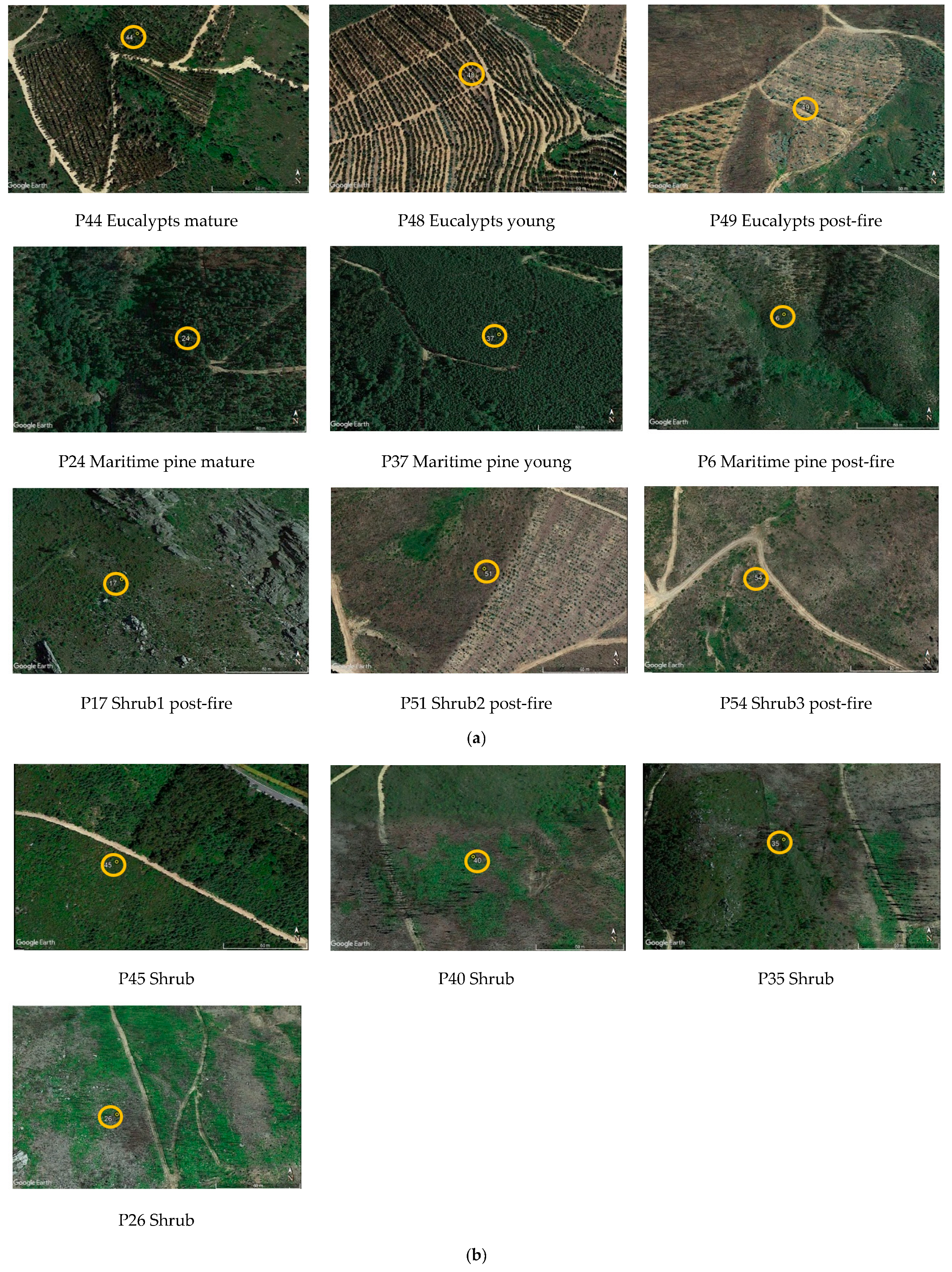


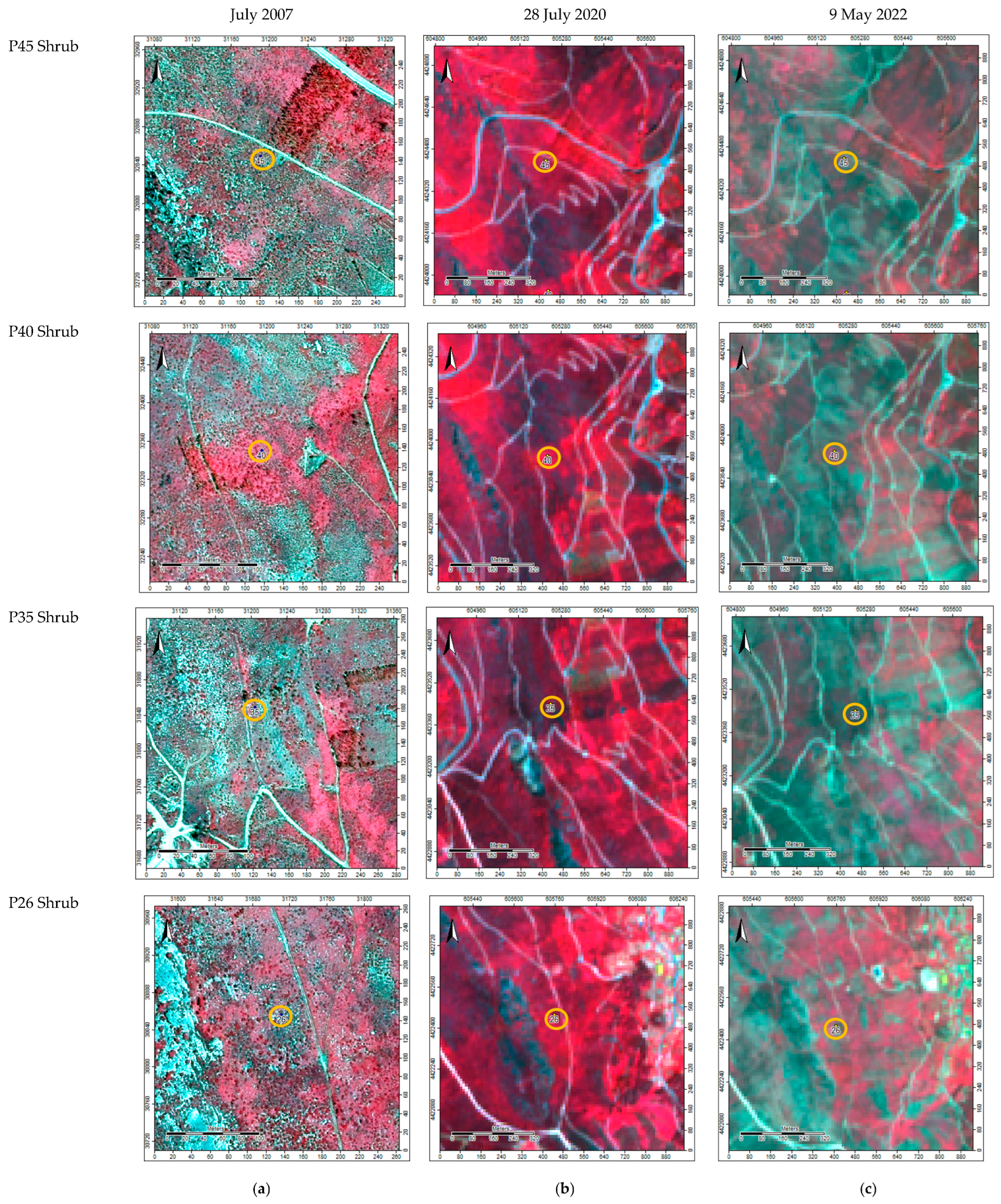
References
- Arroyo, L.A.; Pascual, C.; Manzanera, J.A. Fire models and methods to map fuel types: The role of remote sensing. For. Ecol. Manag. 2008, 256, 1239–1252. [Google Scholar] [CrossRef]
- Fernández-Manso, A.; Fernández-Manso, O.; Quintano, C. SENTINEL-2A red-edge spectral indices suitability for discriminating burn severity. Int. J. Appl. Earth Obs. Geoinf. 2016, 50, 170–175. [Google Scholar] [CrossRef]
- Sobrino, J.A.; Llorens, R.; Fernández, C.; Fernández-Alonso, J.M.; Vega, J.A. Relationship between forest fires severity measured in situ and through remotely sensed spectral indices. Forests 2019, 10, 457. [Google Scholar] [CrossRef]
- Llorens, R.; Sobrino, J.A.; Fernández, C.; Fernández-Alonso, J.M.; Vega, J.A. A methodology to estimate forest fires burned areas and burn severity degrees using Sentinel-2 data. Application to the October 2017 fires in the Iberian Peninsula. Int. J. Appl. Earth Obs. Geoinf. 2021, 95, 102243. [Google Scholar] [CrossRef]
- García, M.; Riaño, D.; Chuvieco, E.; Salas, J.; Danson, F.M. Multispectral and LiDAR data fusion for fuel type mapping using Support Vector Machine and decision rules. Remote Sens. Environ. 2011, 115, 1369–1379. [Google Scholar] [CrossRef]
- Moreira, F.; Viedma, O.; Arianoutsou, M.; Curt, T.; Koutsias, N.; Rigolot, E.; Barbati, A.; Corona, P.; Vaz, P.; Xanthopoulos, G.; et al. Landscape—wildfire interactions in southern Europe: Implications for landscape management. J. Environ. Manag. 2011, 92, 2389–2402. [Google Scholar] [CrossRef]
- Lasaponara, R.; Lanorte, A. Remotely sensed characterization of forest fuel types by using satellite ASTER data. Int. J. Appl. Earth Obs. Geoinf. 2007, 9, 225–234. [Google Scholar] [CrossRef]
- Xie, Y.; Sha, Z.; Yu, M. Remote sensing imagery in vegetation mapping: A review. J. Plant Ecol. 2008, 1, 9–23. [Google Scholar] [CrossRef]
- Fornacca, D.; Ren, G.; Xiao, W. Evaluating the best spectral indices for the detection of burn scars at several post-fire dates in a Mountainous Region of Northwest Yunnan, China. Remote Sens. 2018, 10, 1196. [Google Scholar] [CrossRef]
- Lillesand, T.; Kiefer, R. Remote Sensing and Image Interpretation; John Wiley & Sons: New York, NY, USA; Chichester, UK; Brisbane, Australia; Toronto, ON, Canada; Singapore, 1994; 376p. [Google Scholar]
- Kumar, L.; Sinha, P.; Taylor, S.; Alqurashi, A.F. Review of the use of remote sensing for biomass estimation to support renewable energy generation. J. Appl. Remote Sens. 2015, 9, 97696. [Google Scholar] [CrossRef]
- Berra, E.F.; Fontana, D.C.; Kuplich, T.M. Tree Age As Adjustment Factor to Ndvi. Rev. Árvore 2017, 41, e410307. [Google Scholar] [CrossRef]
- Gizachew, B.; Solberg, S.; Næsset, E.; Gobakken, T.; Bollandsås, O.M.; Breidenbach, J.; Zahabu, E.; Mauya, E.W. Mapping and estimating the total living biomass and carbon in low-biomass woodlands using Landsat 8 CDR data. Carbon Balance Manag. 2016, 11, 13. [Google Scholar] [CrossRef] [PubMed]
- Santos, L.H.O.; Ramirez, G.M.; Roque, M.W.; de Lima Chaves, M.P.; Diaz, L.M.G.R.; Chaves, S.P. Correlação entre uniformidade e NDVI em povoamentos de Tectona grandis L. f. BIOFIX Sci. J. 2019, 4, 130. [Google Scholar] [CrossRef]
- Erasmi, S.; Klinge, M.; Dulamsuren, C.; Schneider, F.; Hauck, M. Modelling the productivity of Siberian larch forests from Landsat NDVI time series in fragmented forest stands of the Mongolian forest-steppe. Environ. Monit. Assess. 2021, 193, 200. [Google Scholar] [CrossRef]
- Mendes, T.R.S.; Miguel, E.P.; Vasconcelos, P.G.A.; Valadão, M.B.X.; Rezende, A.V.; Matricardi, E.A.T.; Angelo, H.; Gatto, A.; Nappo, M.E. Use of aerial image in the estimation of volume and biomass of Eucalyptus sp. forest stand. Aust. J. Crop Sci. 2020, 14, 286–294. [Google Scholar] [CrossRef]
- Amos, C.; Petropoulos, G.P.; Ferentinos, K.P. Determining the use of Sentinel-2A MSI for wildfire burning & severity detection. Int. J. Remote Sens. 2019, 40, 905–930. [Google Scholar] [CrossRef]
- Huang, H.; Roy, D.P.; Boschetti, L.; Zhang, H.K.; Yan, L.; Kumar, S.S.; Gomez-Dans, J.; Li, J. Separability analysis of Sentinel-2A Multi-Spectral Instrument (MSI) data for burned area discrimination. Remote Sens. 2016, 8, 873. [Google Scholar] [CrossRef]
- Huang, S.; Tang, L.; Hupy, J.P.; Wang, Y.; Shao, G. A commentary review on the use of normalized difference vegetation index (NDVI) in the era of popular remote sensing. J. For. Res. 2021, 32, 1–6. [Google Scholar] [CrossRef]
- Veraverbeke, S.; Lhermitte, S.; Verstraeten, W.W.; Goossens, R. The temporal dimension of differenced Normalized Burn Ratio (dNBR) fire/burn severity. Remote Sens. Environ. 2010, 114, 2548–2563. [Google Scholar] [CrossRef]
- Forkel, M.; Carvalhais, N.; Verbesselt, J.; Mahecha, M.D.; Neigh, C.S.R.; Reichstein, M. Trend Change detection in NDVI time series: Effects of inter-annual variability and methodology. Remote Sens. 2013, 5, 2113–2144. [Google Scholar] [CrossRef]
- Zhao, X.; Xu, P.; Zhou, T.; Li, Q.; Wu, D. Distribution and variation of forests in china from 2001 to 2011: A study based on remotely sensed data. Forests 2013, 4, 632–649. [Google Scholar] [CrossRef]
- Yang, Y.; Wu, T.; Wang, S.; Li, J.; Muhanmmad, F. The NDVI-CV Method for mapping evergreen trees in complex urban areas using reconstructed landsat 8 time-series data. Forests 2019, 10, 139. [Google Scholar] [CrossRef]
- Navarro, A.; Catalao, J.; Calvao, J. Assessing the use of Sentinel-2 time series data for monitoring Cork Oak decline in Portugal. Remote Sens. 2019, 11, 2515. [Google Scholar] [CrossRef]
- Petropoulos, G.P.; Griffiths, H.M.; Kalivas, D.P. Quantifying spatial and temporal vegetation recovery dynamics following a wildfire event in a Mediterranean landscape using EO data and GIS. Appl. Geogr. 2014, 50, 120–131. [Google Scholar] [CrossRef]
- Lentile, L.B.; Holden, Z.A.; Smith, A.M.S.; Falkowski, M.J.; Hudak, A.T.; Morgan, P.; Lewis, S.A.; Gessler, P.E.; Benson, N.C. Remote sensing techniques to assess active fire characteristics and post-fire effects. Int. J. Wildl. Fire 2006, 15, 319–345. [Google Scholar] [CrossRef]
- Gitas, I.Z.; De Santis, A.; Mitri, G.H. Remote sensing of burn severity. In Earth Observation of Wildland Fires in Mediterranean Ecosystems; Springer: Berlin/Heidelberg, Germany, 2009; pp. 129–148. ISBN 9783642017537. [Google Scholar]
- Fernandes, P.M.; Luz, A.; Loureiro, C. Changes in wildfire severity from maritime pine woodland to contiguous forest types in the mountains of northwestern Portugal. For. Ecol. Manag. 2010, 260, 883–892. [Google Scholar] [CrossRef]
- ICNF. 6° Inventário Florestal Nacional—IFN6. 2015. Relatório Final; Instituto da Conservação da Natureza e das Florestas: Lisboa, Portugal, 2019; 284p, Available online: https://www.icnf.pt/api/file/doc/c8cc40b3b7ec8541 (accessed on 1 September 2022).
- DGT. Carta de Uso e Ocupação do Solo. Registo Nacional de Dados Geográficos; SNIG. Direção-Geral do Território: Lisboa, Portugal. Available online: https://snig.dgterritorio.gov.pt/rndg/srv/por/catalog.search#/search?anysnig=COS&fast=index (accessed on 1 September 2022).
- ICNF. Informação Geográfica. Territórios ardidos (formato “shapefile”): 1990–1999; 2000–2008; 2009; 2010; 2011; 2012; 2013; 2014; 2015; 2016; 2017; 2018; e 2019; Instituto da Conservação da Natureza e das Florestas: Lisboa, Portugal; Available online: https://geocatalogo.icnf.pt/catalogo_tema5.html (accessed on 1 September 2022).
- Alegria, C.; Teixeira, M.C. An overview of maritime pine private non-industrial forest in the centre of Portugal: A 19-year case study. Folia For. Pol. Ser. A For. 2016, 58, 198–213. [Google Scholar] [CrossRef][Green Version]
- Vanclay, J.K. Modelling Forest Growth and Yield. Applications to Mixed Tropical Forests; CAB International: Wallingford, UK, 1994; 312p. [Google Scholar]
- Alegria, C. Simulation of silvicultural scenarios and economic efficiency for maritime pine (Pinus pinaster Aiton) wood-oriented management in centre inland of Portugal. For. Syst. 2011, 20, 361–378. [Google Scholar] [CrossRef]
- Faias, S.P. Analysis of Biomass Expansion Factors for the Most Important Tree Species in Portugal. Master’s Thesis, Universidade Técina de Lisboa, Instituto Superior de Agronomia, Lisboa, Portugal, 2009; 48p. [Google Scholar]
- Navarro, G.; Caballero, I.; Silva, G.; Parra, P.-C.; Vázquez, Á.; Caldeira, R. Evaluation of forest fire on Madeira Island using Sentinel-2A MSI imagery. Int. J. Appl. Earth Obs. Geoinf. 2017, 58, 97–106. [Google Scholar] [CrossRef]
- IPMA. Boletins Climatológicos de Portugal Continental. Instituto Português do Mar e da Atmosfera. Available online: https://www.ipma.pt/pt/publicacoes/boletins.jsp?cmbDep=cli&cmbTema=pcl&idDep=cli&idTema=pcl&curAno=-1 (accessed on 1 September 2022).
- WEKA. WEKA Software, Machine Learning Group at the University of Waikato: Waikato, New Zealand. Available online: https://www.cs.waikato.ac.nz/ml/weka/ (accessed on 1 September 2022).
- Hall, M.; Frank, E.; Holmes, G.; Pfahringer, B.; Reutemann, P.; Witten, I.H. The WEKA data mining software: An update. SIGKDD Explor. 2008, 11, 10–18. [Google Scholar] [CrossRef]
- EOS NDVI FAQ: All You Need to Know about Index. Available online: https://eos.com/blog/ndvi-faq-all-you-need-to-know-about-ndvi/ (accessed on 13 September 2022).
- Shobairi, S.O.R.; Li, M.Y. Evaluation Methods of Predicting Forest Carbon Stocks with Remote Sensing. Res. J. For. 2016, 3, 1–16. [Google Scholar]
- Man, Q.; Dong, P.; Guo, H.; Liu, G.; Shi, R. Light detection and ranging and hyperspectral data for estimation of forest biomass: A review. J. Appl. Remote Sens. 2014, 8, 081598. [Google Scholar] [CrossRef]
- Cárdenas, J.L.S.; Romero, N.C.; Pizaña, J.M.G.; Hernández, J.M.N.; Gómez, J.M.M. Old-Growth Forests and Coniferous Forests: Ecology, Habitat and Conservation. In Geospatial Technologies to Support Coniferous Forests Research and Conservation Efforts in Mexico; Weber, R.B., Ed.; Nova Science Publishers: Hauppauge, NY, USA, 2015; pp. 67–123. [Google Scholar]
- Soares, P.; Calado, N.; Carneiro, S. Manual de Boas Práticas Para o Pinheiro-Bravo; Centro PINUS: Viana do Castelo, Portugal, 2020; 34p, Available online: https://www.centropinus.org/files/upload/edicoes_tecnicas/silvicultura-centro-pinus-digital.pdf (accessed on 1 September 2022).
- Silva, J.S.; Vaz, P.; Moreira, F.; Catry, F.; Rego, F.C. Wildfires as a major driver of landscape dynamics in three fire-prone areas of Portugal. Landsc. Urban Plan. 2011, 101, 349–358. [Google Scholar] [CrossRef]
- IPMA. In Boletim Seca Meteorológica—15 de Março 2022; Instituto Português do Mar e da Atmosfera: Lisbon, Portugal, 2022; 7p.
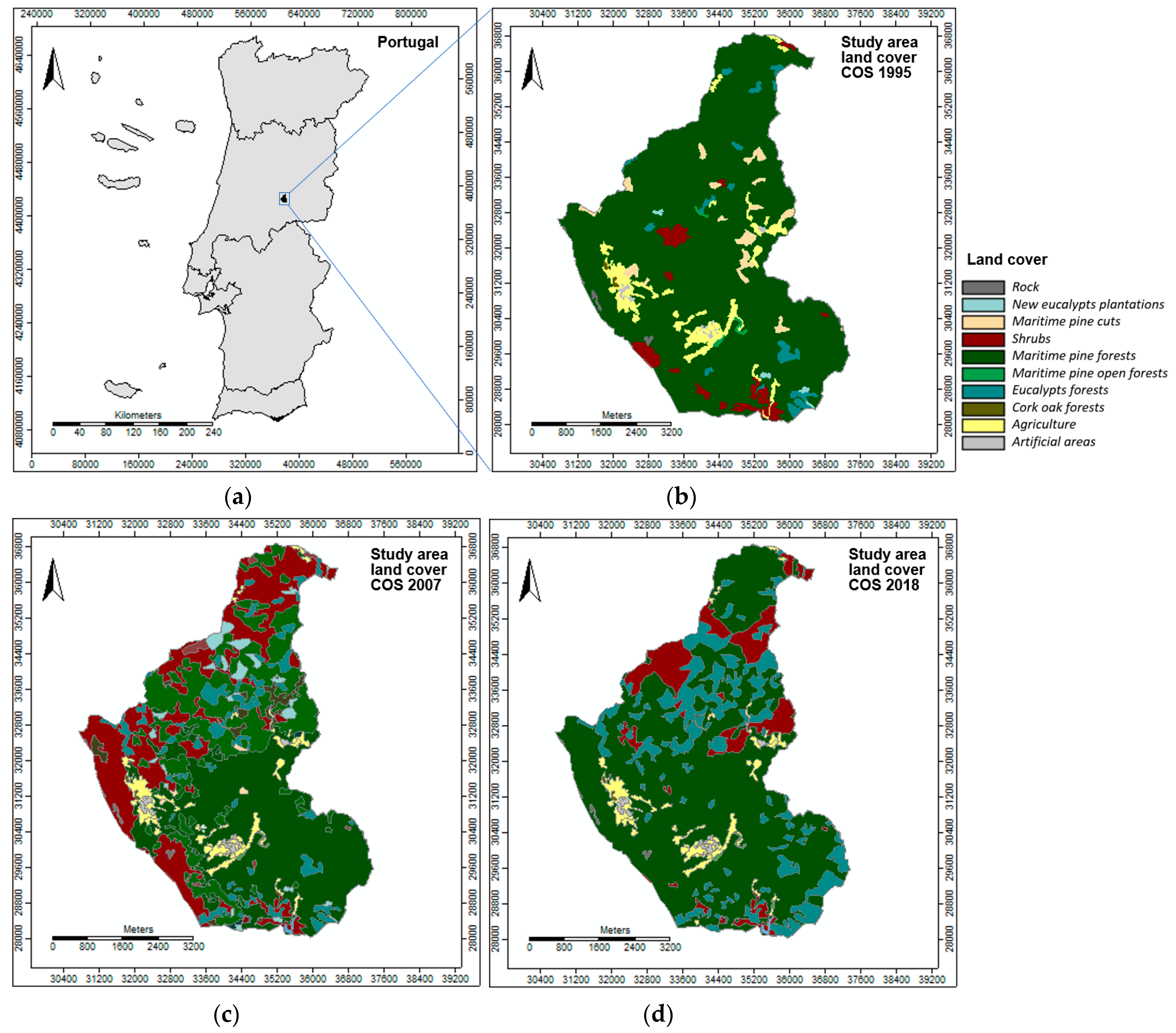

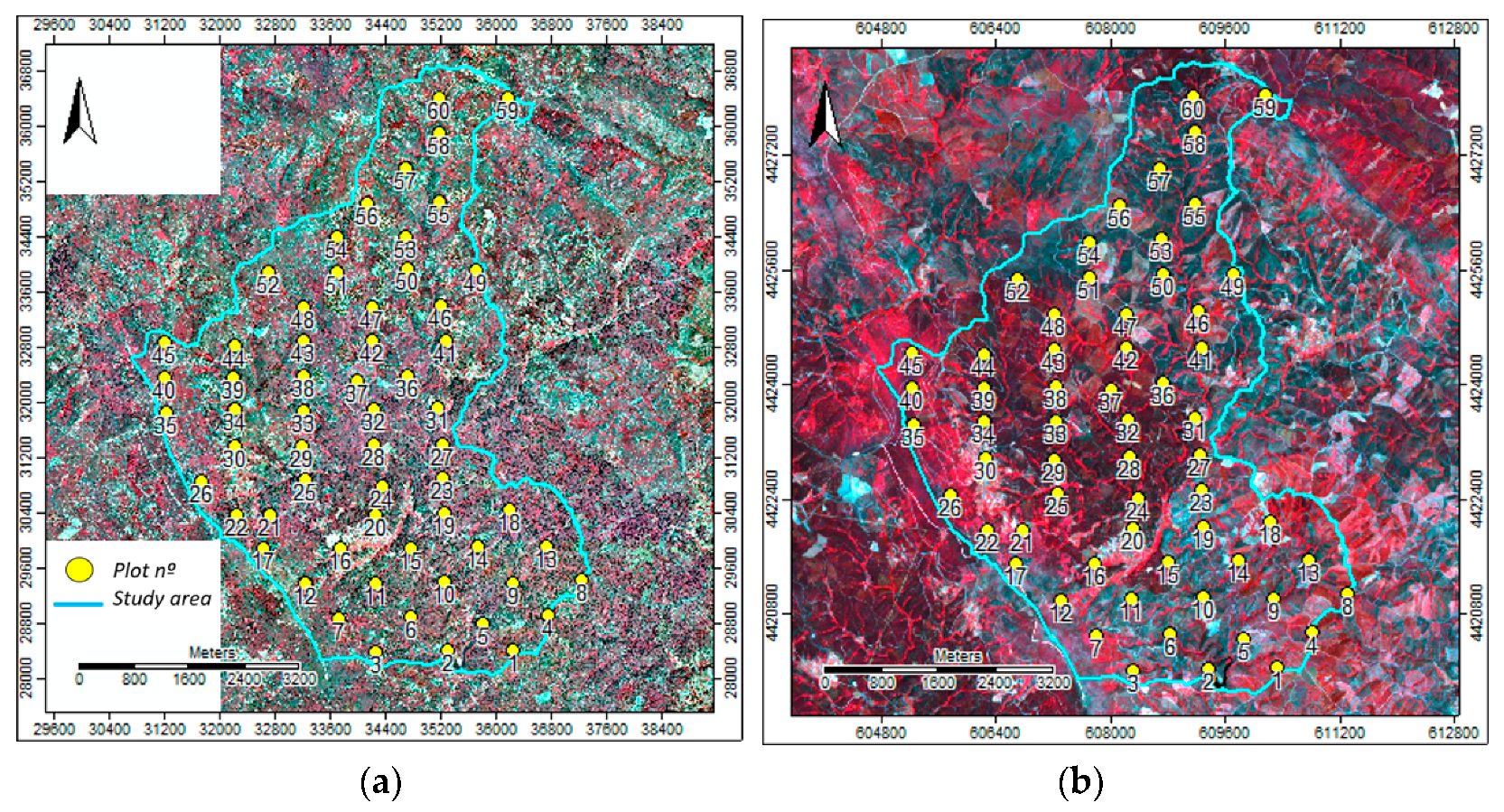




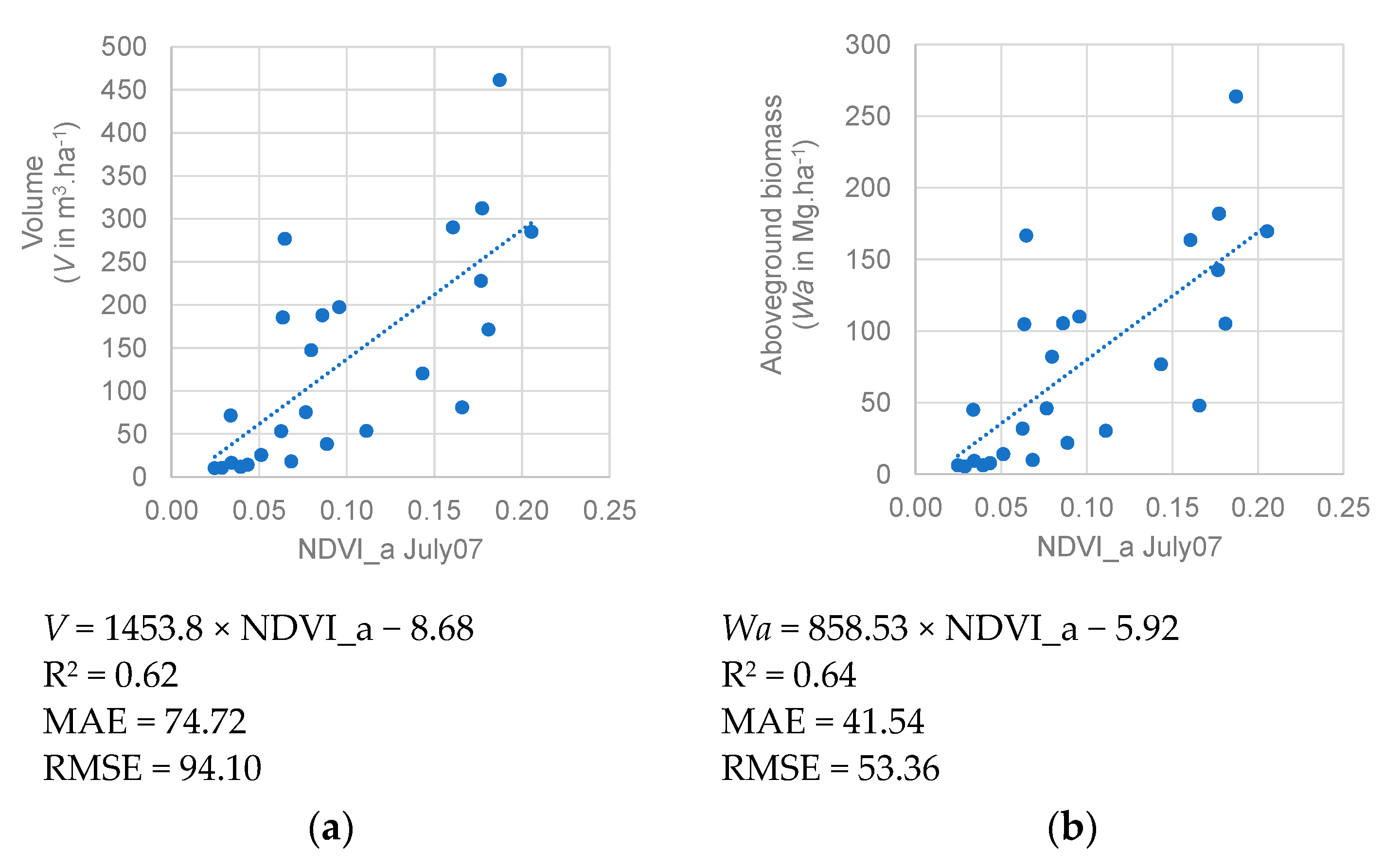


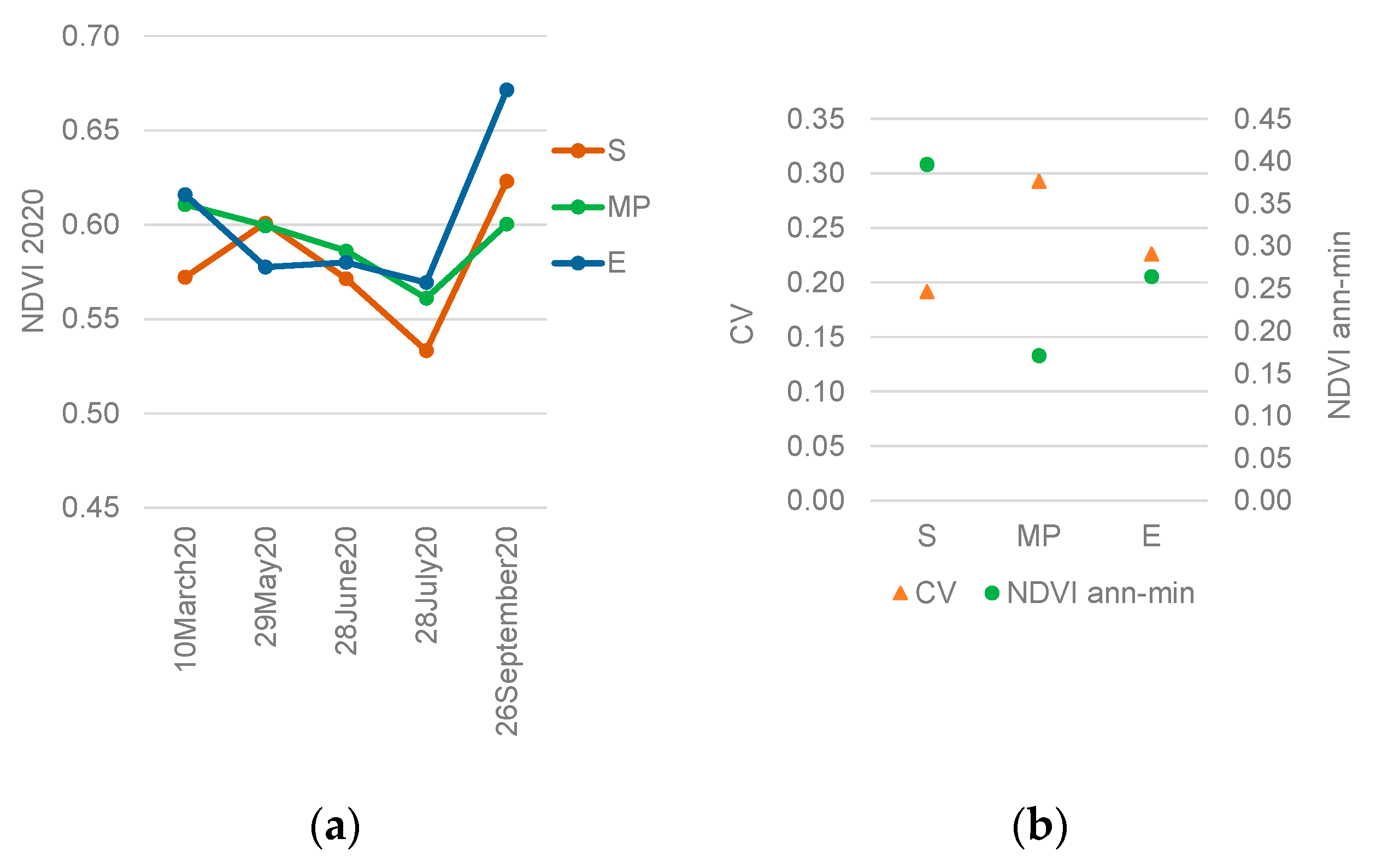
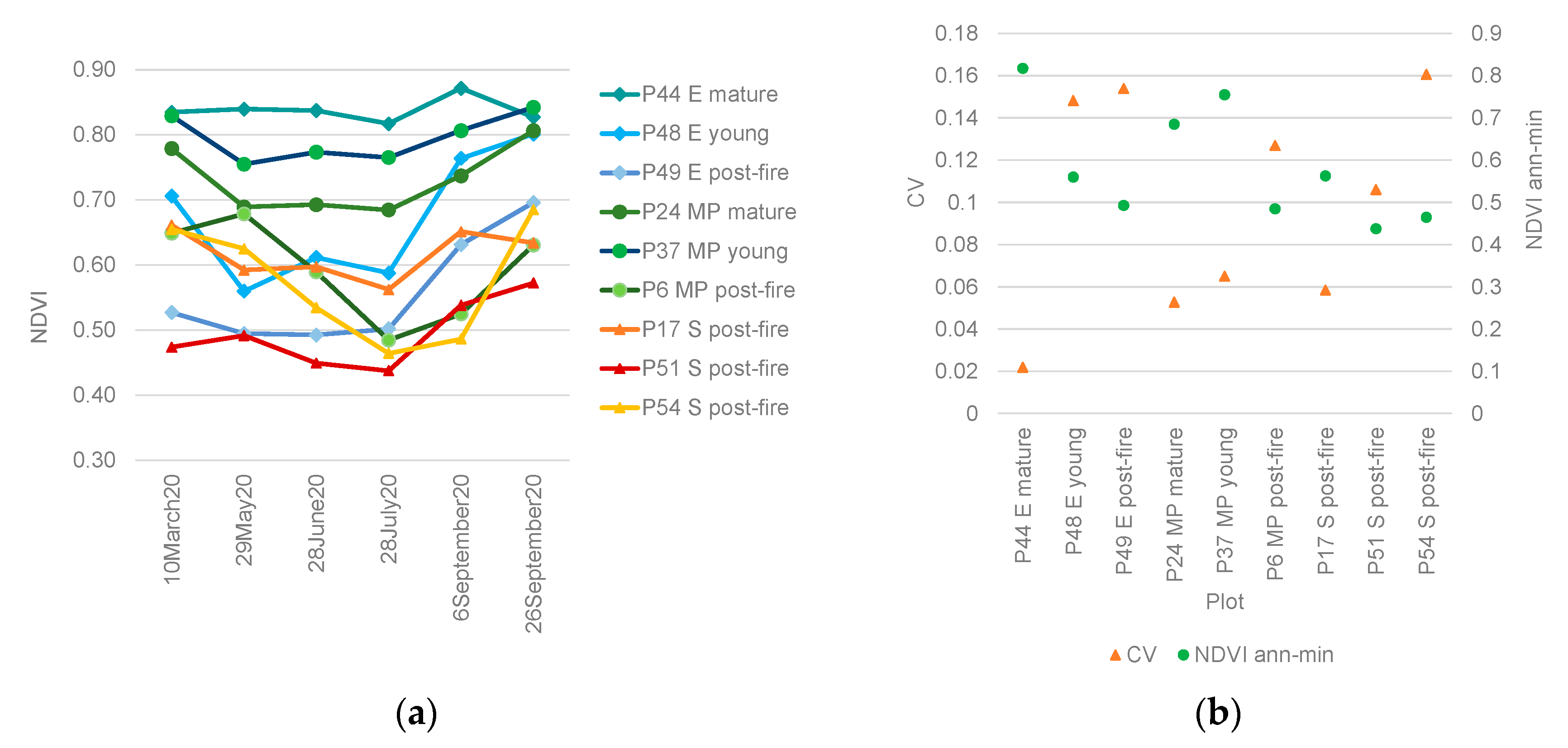
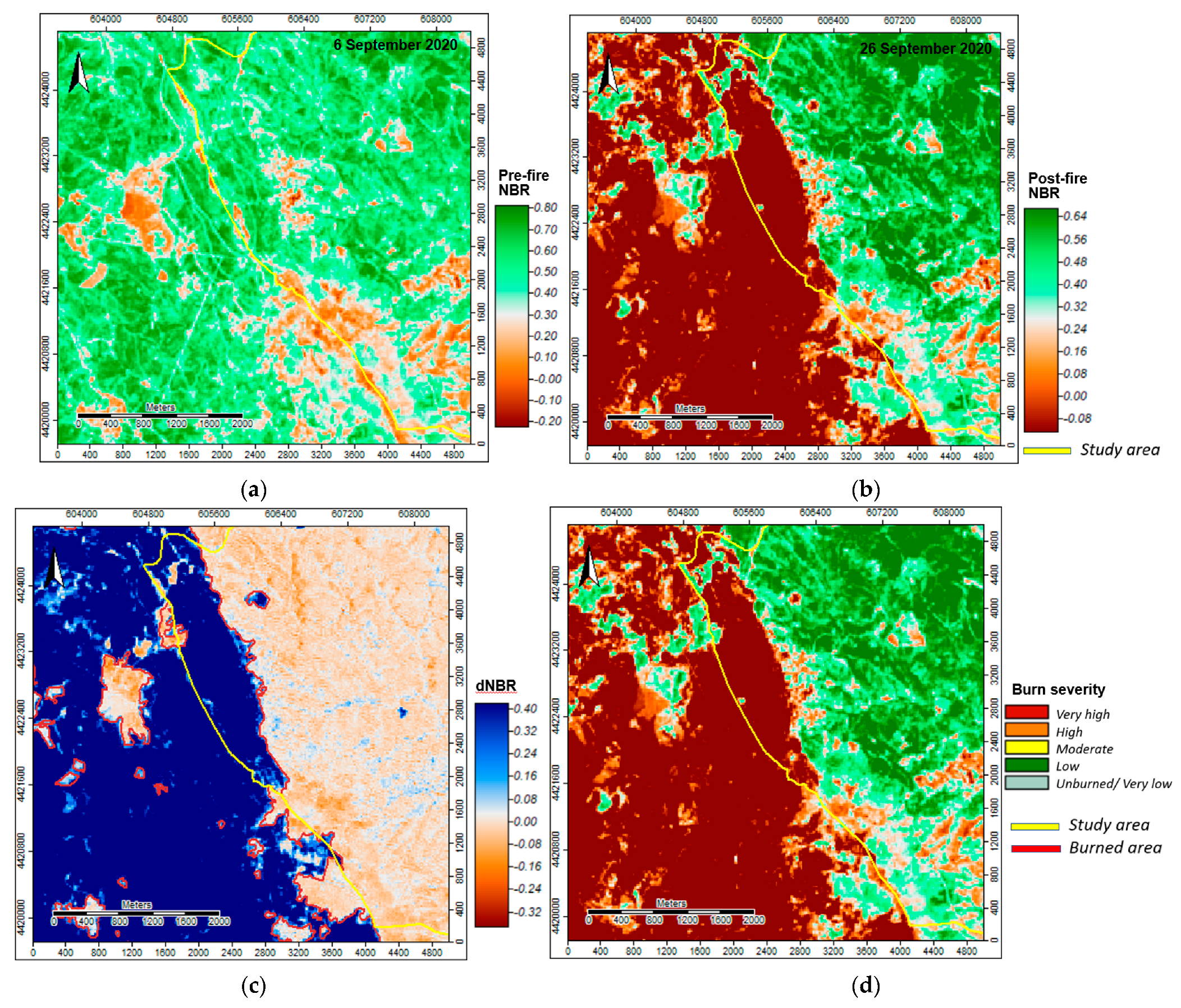
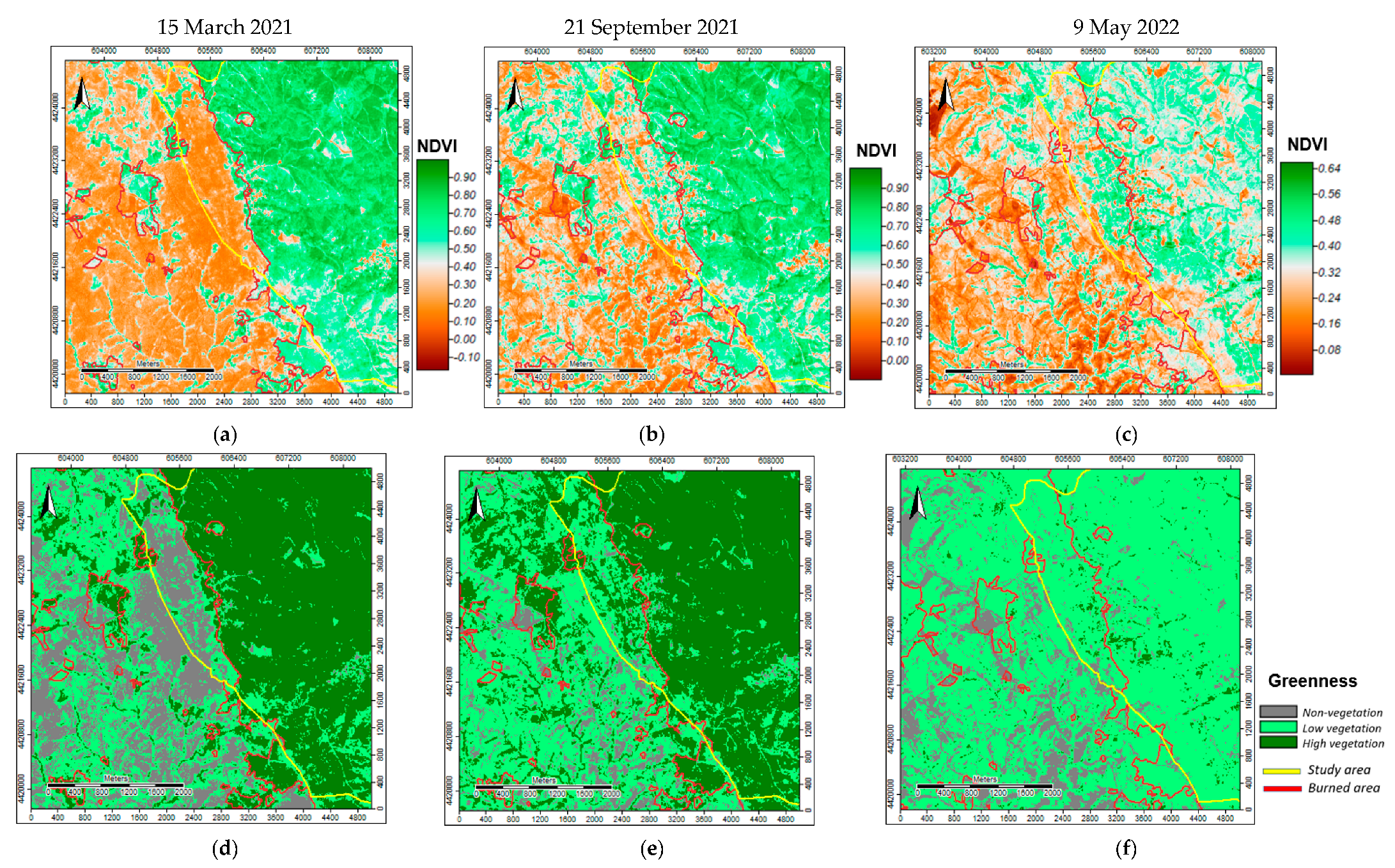


| Variables | n | Min. | Max. | Mean | SD | |
|---|---|---|---|---|---|---|
| Tall regeneration—seedlings mean height ≥ 1.30 m | ||||||
| Ground cover | GC (%) | 6 | 10 | 30 | 18 | 7.6 |
| Number of seedlings per ha | Ns (seedlings ha−1) | 8 | 1000 | 50,000 | 32,625 | 15,519.0 |
| Seedlings mean age | (years) | 8 | 3 | 4 | 4 | 0.4 |
| Short regeneration—seedlings mean height < 1.30 m | ||||||
| Ground cover | GC (%) | 8 | 10 | 90 | 62 | 31.6 |
| Number of seedlings per ha | Ns (seedlings ha−1) | 10 | 300 | 30,000 | 8442 | 10,860.1 |
| Variables | Min. | Max. | Mean | SD | |
|---|---|---|---|---|---|
| Number of trees per ha | N (trees ha−1) | 340 | 2800 | 970 | 730.57 |
| Basal area per ha | G (m2 ha−1) | 2.31 | 45.69 | 18.04 | 12.80 |
| Quadratic mean diameter | dg (cm) | 6.64 | 31.55 | 16.41 | 8.54 |
| Mean height | (m) | 6.26 | 21.25 | 12.58 | 5.11 |
| Dominant diameter | ddom (cm) | 8.83 | 40.32 | 22.92 | 10.85 |
| Dominant height | hdom (m) | 7.50 | 25.56 | 15.14 | 5.22 |
| Wilson’s Factor | Fw | 0.15 | 0.62 | 0.28 | 0.13 |
| Stand age | t (year) | 7 | 40 | 21 | 11.03 |
| Site productivity | Sh25 (m) | 12.09 | 22.24 | 16.98 | 2.44 |
| Total volume | V (m3 ha−1) | 10.51 | 461.38 | 133.80 | 122.10 |
| Stem under bark biomass | Ws (Mg ha−1) | 2.99 | 195.04 | 54.11 | 51.67 |
| Bark biomass | Wb (Mg ha−1) | 0.85 | 23.95 | 8.55 | 6.76 |
| Branches biomass | Wbr (Mg ha−1) | 0.61 | 32.84 | 10.13 | 9.44 |
| Leaves biomass | Wl (Mg ha−1) | 0.78 | 11.94 | 5.43 | 3.45 |
| Aboveground biomass | Wa (Mg ha−1) | 5.59 | 263.77 | 78.22 | 70.91 |
| Roots biomass | Wr (Mg ha−1) | 1.92 | 16.82 | 8.12 | 4.43 |
| Tree biomass | W (Mg ha−1) | 8.18 | 277.29 | 86.34 | 73.74 |
| Year | Date of Acquisition | |||||||||||
|---|---|---|---|---|---|---|---|---|---|---|---|---|
| January | February | March | April | May | June | July | August | September | October | November | December | |
| 2020 | 10 | 29 | 28 | 28 | 26 | |||||||
| 2021 | 15 | 14 | 21 | |||||||||
| 2022 | 30 | 9 | ||||||||||
| Band | Name | Central Wavelength (nm) | Spatial Resolution (m) |
|---|---|---|---|
| 1 | Coastal aerosol | 443 | 60 |
| 2 | Blue | 490 | 10 |
| 3 | Green | 560 | 10 |
| 4 | Red | 665 | 10 |
| 5 | Red-edge 1 | 705 | 20 |
| 6 | Red-edge 2 | 740 | 20 |
| 7 | Red-edge 3 | 783 | 20 |
| 8 | Near Infrared (NIR) | 842 | 10 |
| 8a | NIR narrow | 865 | 20 |
| 9 | Water vapor | 945 | 60 |
| 10 | Cirrus | 1375 | 60 |
| 11 | Short-wave Infrared (SWIR) 1 | 1610 | 20 |
| 12 | SWIR 2 | 2190 | 20 |
| Acronym | Spectral Bands | Formula |
|---|---|---|
| R—red band | ||
| NDVI | NIR | |
| SWIR | ||
| NBR | NIR |
| EFFIS Thresholds | Severity Level |
|---|---|
| dNBR < 0.100 | Unburned/Very low |
| 0.100 ≤ dNBR ≤ 0.255 | Low |
| 0.256 ≤ dNBR ≤ 0.419 | Moderate |
| 0.420 ≤ dNBR ≤ 0.660 | High |
| dNBR > 0.660 | Very high |
| Thresholds | Greenness Classes |
|---|---|
| NDVI < 0.2 | Non-vegetation |
| 0.2 ≤ NDVI < 0.5 | Low vegetation |
| NDVI ≥ 0.5 | High vegetation |
Publisher’s Note: MDPI stays neutral with regard to jurisdictional claims in published maps and institutional affiliations. |
© 2022 by the author. Licensee MDPI, Basel, Switzerland. This article is an open access article distributed under the terms and conditions of the Creative Commons Attribution (CC BY) license (https://creativecommons.org/licenses/by/4.0/).
Share and Cite
Alegria, C. Vegetation Monitoring and Post-Fire Recovery: A Case Study in the Centre Inland of Portugal. Sustainability 2022, 14, 12698. https://doi.org/10.3390/su141912698
Alegria C. Vegetation Monitoring and Post-Fire Recovery: A Case Study in the Centre Inland of Portugal. Sustainability. 2022; 14(19):12698. https://doi.org/10.3390/su141912698
Chicago/Turabian StyleAlegria, Cristina. 2022. "Vegetation Monitoring and Post-Fire Recovery: A Case Study in the Centre Inland of Portugal" Sustainability 14, no. 19: 12698. https://doi.org/10.3390/su141912698
APA StyleAlegria, C. (2022). Vegetation Monitoring and Post-Fire Recovery: A Case Study in the Centre Inland of Portugal. Sustainability, 14(19), 12698. https://doi.org/10.3390/su141912698






